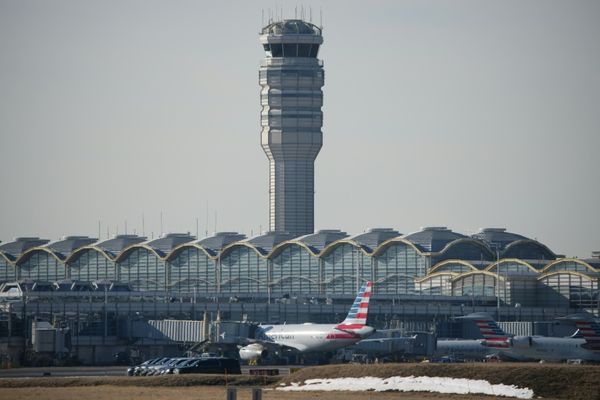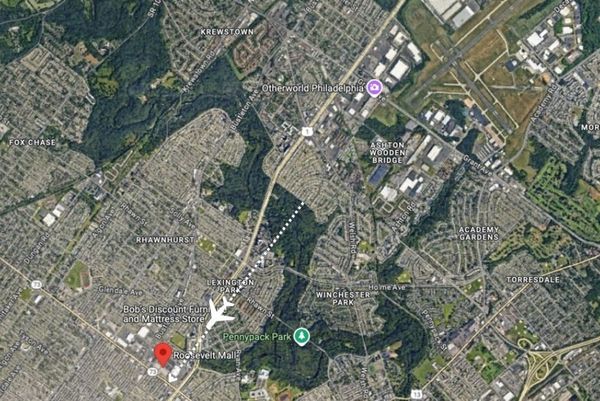
There was purposeful work being done inside the expansive food bank warehouse, with Michael Jackson’s Billie Jean blasting from a small stereo near the loading dock to help spur the groups of volunteers inside the 60,000-sq-ft facility.
Almost two years into the pandemic, and now with inflation at a 40-year high, a typical day at the Community Food Bank of Central Alabama (CFBCA) reveals an abundance of activity and cheer belying the steep odds these neighborhood lifelines face.
It’s not just the price of food. On a recent Tuesday with dreary weather outside in Homewood, a suburb of Birmingham, CFBCA community engagement coordinator Steven Hatcher was told a delivery of the flat boxes his team assembles to distribute food hadn’t arrived.

It was another supply chain problem, just one of many. Hatcher walked off in search of news as volunteers chatted while putting together the last few boxes left on site. They’re filled with pre-sorted food items by other volunteers, then loaded on to trucks and distributed to 265 smaller partner agencies serving thousands of families who need food donations across 12 Alabama counties.
“Each box is designed to feed a family of four for a week,” said Hatcher. Without enough boxes, packing and moving donations to the public could be held up, wasting volunteers’ time and delaying food reaching hungry people.
So when a forklift carrying a pallet of 500 boxes cruised through the warehouse at the last minute, there was a sense of relief.
While the volunteers put them together, the food bank’s chief executive, Brett Meredith, was talking prices.
“Pre-pandemic we used to buy a load of vegetables for $15,000 to $17,000. That same load of vegetables today costs between $27,000 and $29,000, from the same suppliers,” he said.
And take peanut butter, which food banks across America rely upon as a nutritious, shelf-stable protein that’s easy to distribute.


“We’ve not had trouble getting it,” Meredith said. “But two years ago we could buy a truckload of peanut butter for probably $45,000. That same truckload six weeks ago cost me $80,000 – and we’ve purchased more food in the last year than we ever have in our history.”
Last year the bank had to pay for more of its food needs because of what Meredith called a six-month “slump” in federal supplies.
The government had been buying farm industry surpluses and providing them to nutritional programs, including food banks, that were in shortfall because of international trade wars during the Trump administration – a Department of Agriculture (USDA) measure known as trade mitigation.
That federal help stopped on 1 January 2021, but without the farm supplies returning as before.
In the first six months of 2021, the bank was getting only 48% of its usual quantity of food arriving this way, and for the second half of 2021 they “gradually built up to about 80%” of what they were receiving in 2020, Meredith said.
Extra work went into encouraging retail reclamation food supplies from partner grocery stores and more food drives with partners, such as the Birmingham Bulls hockey team, to increase community donations.

But instead of giving out fewer boxes or smaller portions during these tough times, leaving the 428,000 people the bank said it helped in 2020 short, it has covered costs for the time being by leaning heavily on donors, grants and financial reserves. CFBCA distributed 21.9m pounds of food in 2020 compared with 13m in 2018.
The total cost of food purchases will be above $3m in 2021, Meredith estimated, three times pre-pandemic costs.
According to a 2020 national report commissioned before the pandemic, one in four children and one in six adults in America experienced hunger on a regular basis and an estimated 35,000 children fall within a “meal gap”, and rely on food banks.
Black families in the US have gone hungry at two to three times the rate of white families over the course of the pandemic, a Guardian investigation last year concluded.
On a chilly morning earlier this month, CFBCA’s supplies rumbled out of the warehouse and trucks fanned out across the region.
One destination was Build-A-Bridge community pantry, a non-profit organization affiliated with Revival Center, a Christian church in Vincent, a rural town of 2,000 residents 30 miles from Birmingham.
CFBCA staff and volunteers arrived bright and early, ready to distribute boxes stuffed with assorted nuts, pork loin, frozen vegetables, butter, cheese and more.


Members of the public began arriving, themselves struggling withhigh food and gas prices and the virus making people sick and wiping out jobs, while government pandemic-related benefits and protections are petering out.
Those picking up food skewed older and on this day were a relatively diverse crowd.
Bonita McCrimmon, a Black senior who lives close by, drove into the lot. McCrimmon is involved with Build-A-Bridge and is also a client.
She said she was there to pick up boxes of food not only for herself but for at least two other families.
“What I get I also share with other people. I’ve got neighbors, older people, and a lot of them don’t have transportation. Some of them have Covid,” she said.
Cars flowed smoothly through the center, boxes of food flying out of volunteers’ hands. Not all visitors were eager to talk about struggling to feed themselves or their children.
Gladys Dennis, a white senior citizen, drove from Sylacauga, 20 miles south, with a friend. Both of them received a box of food and Dennis said she’d visited another mobile pantry a month earlier, each trip taking 20 minutes each way – with inflation-driven gas prices.
“But we don’t have anything else,” she said of the food banks and community pantries. “It feels really good to know that they help a lot of people, especially older people.”

Volunteer Angela Traweek helps lead Build-A-Bridge, which currently operates two days a week, serving Vincent and its surrounding cities with provisions sourced from the CFBCA.
She said the pantry had 22,000lb of food to distribute that day, enough to feed 300 families.
During a lull in traffic, before which Traweek had greeted everyone with huge smiles and inquiries about how they were doing, she said: “We have so many people. The list of clients is growing tremendously with inflation, the higher prices of groceries, and we’re getting more and more people that come in. So eventually, we may have more days.”
Her voice broke as she talked of people’s hardship.
“It brings tears to your eyes when you have the elderly come through and say, ‘We paid our rent and our light bills, but we didn’t know if we were going to have anything to eat because we had to buy our medicine.’”
Then she turned, smiling, to the next car approaching.


Back at the food bank warehouse, Meredith, who arrived in the job less than two years ago, said he had been in the process improving long-term planning at the 38-year-old bank when the coronavirus pandemic hit and, over time, supply chain problems mounted.
“Food banks like Atlanta’s, Nashville, east Tennessee, Memphis, they’ve all developed, they all, you know, they kind of put their stake in the ground 10 to 20 years ago … we planned week-to-week … and we can’t do that any more,” Meredith said.
He continued: “It does require much more planning, and that’s a good thing, because it forces us to do the things I think we need to do. In our 12-county area, the food insecurity rate is about 45.8m meals this year. We’re going to be able to provide between 15m and 16m meals, only about a third of the need. We have to grow that because within 10 years we need to be at 85 or 90%.”
Right now, as the pandemic drags on and inflation fails to abate, the bank is also dealing with staff shortages, as are so many employers.
“Drivers are in short supply. We had a driver who gave us two days’ notice before he left. You’re really put in a difficult position when you lose someone who’s been with the company for years in days’ time. If we were to lose three or four people in a short period of time – say, in operations – we’d be hard-pressed to be able to fulfill what we need to fulfill,” Meredith said.

And in an echo of the erratic box delivery problem, efforts to reach donors has been hampered by, of all things, problems with paper supplies to send out letters, in a region where many, especially in more rural areas, often rely more on newspapers, snail mail and post office boxes than the internet.
Nicole Williams, the food bank’s director of development, said of the organization’s holiday season fundraising efforts: “At this time of year we do a lot of direct mail asking for donor gifts that come in. There’s a paper shortage, so all our mailings were three weeks late, which means we haven’t brought in as much money as we usually do. So that’s been frustrating.”
Despite the Omicron surge and other obstacles, staff and volunteers worked smoothly in unison, as Blackstreet’s Don’t Leave Me was blasting out and the food boxes were stacking up.
Meredith summed up: “If I was a glass-half-empty kind of guy, I’d be wringing my hands. But I don’t think that serves any purpose. I believe that we just keep doing what we’re doing, and doing it very well.”







